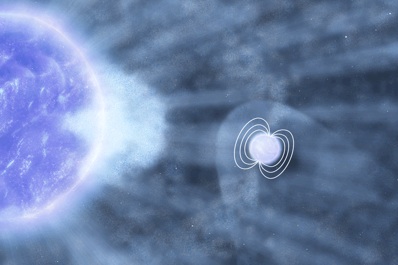
Neutron star chokes
on matter
DR EMILY BALDWIN
ASTRONOMY NOW
Posted: 30 June 2011


ESA's XMM-Newton space observatory watched on as a giant clump of matter ejected from a blue supergiant engulfed its companion neutron star, causing it to flare to 10,000 times its normal brightness.
The system, known as IGR J18410-0535, comprises a dense neutron star – the collapsed core of a once large star that is now cramming around 1.5 solar masses into a 10 kilometre-wide object – and a blue supergiant, which is about 20 times bigger and 30 times more massive than our Sun with a strong stellar wind.
"The wind of our Sun is travelling across the Solar System at a few hundred kilometres per second, while the supergiant stars have winds that are travelling at thousands of kilometres per second," says lead researcher Enrico Bozzo of the University of Geneva, Switzerland. "These winds are so strong that, while propagating away from the star, they form clumps of material that gets more and more compact and constitute a kind of huge "bullet". When one of these bullets hits the neutron star, we observe a bright flare from the neutron star hosted in the system."



This series of images shows the partial ingestion of a clump of matter by the neutron star in the supergiant fast X-ray transient system IGR J18410-0535. XMM-Newton detected the collision of the material with the neutron star as it flared in X-rays. Image: ESA/AOES Medialab.
Observations made during a scheduled 12.5 hour observation of the system with XMM-Newton serendipitously tracked an entire four-hour flare event, during which time material pushed out by the supergiant and attracted by the strong gravitational field of the neutron star was heated to millions of degrees, flaring brightly at X-ray wavelengths. Such an event can be expected only a few times a year for this particular star system.
Since the neutron star is quickly orbiting the companion the amount of material it receives from the supergiant is almost constant, and thus for the so-called classical supergiant high mass X-ray binaries a near constant level of X-ray emission is expected.
"For some unknown reason, this is not what is happening in what we call supergiant fast X-ray transients, even though they have the same basic ingredients: a similar neutron star orbiting a similar supergiant star," says Bozzo. "But instead of being persistent objects in X-rays they display extremely high variations in their luminosity in the X-ray domain."
Bozzo tells Astronomy Now that there is "something peculiar" that is blocking the emission of X-rays for most of the orbital motion, which permits the release of X-rays only for a few hours a few times per year. "Perhaps the wind of the supergiant stars in the transients is not smooth but characterized by the presence of clumps – big bubbles of material thousands of times the size of our Moon," he says. In this scenario, the neutron star is surrounded by a very rarefied wind for most of the orbits and emits short flares in X-rays only when it is randomly shot by one of these clumps."
The idea of the clumpy wind has been supported by several studies, but any clear direct evidence for the existence of these clumps had not, until now, been presented. "Catching completely by chance a bright flare from one transient with XMM-Newton permitted our group to provide the first clear evidence of the existence of these massive clumps. It was an unrepeatable stroke of luck," adds Bozzo.
|



